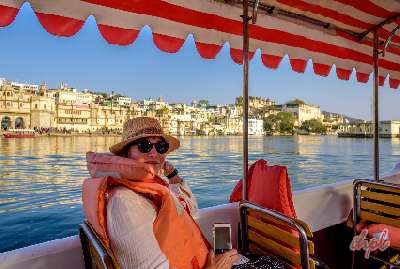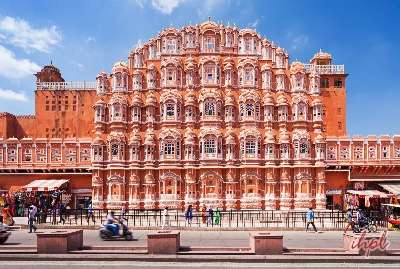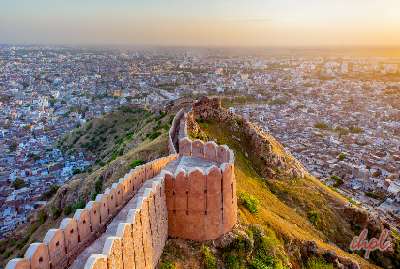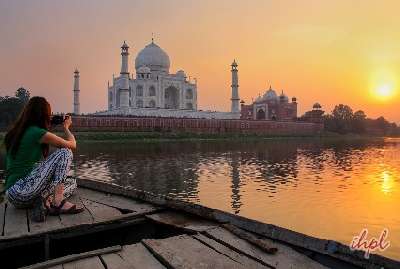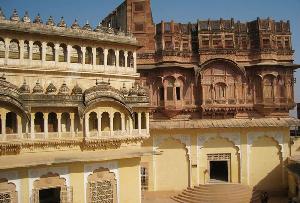Khimsar, a peaceful village known for its imposing fort and scenic beauty. The Khimsar Fort offers a royal holiday, blending history and luxury in a serene setting. With 34 years of expertise, Indian Holiday brings you the best-customised tour packages and trusted local support, ensuring a journey as royal as Rajasthan itself.
Still, wondering why Indian Holiday is your best choice? Read this: Your Complete Guide to Stress-Free Group Travel with Indian Holiday How to Plan a Stress-Free Family Vacation with Indian Holiday
Khimsar is a small hamlet at Rajasthan’s edge of the Great Thar Desert. Amid the dry sandy desert, this village has a water body, which is a picturesque oasis. The serene beauty of the desert village is incomparable. The village has been on the tourist map for its magnificent forts, palaces, temples, and endless magical desert. Midway between Jodhpur and Bikaner, it was once a royal dynasty of the Rajputana. Tales of galore still linger in the ambiance.
Explore 24 Days Rajasthan Gujarat tour package
Here is the detailed Khimsar Tourism Guide, including history, attractions, the best time to visit, how to reach, and more. It will help you plan a trip to Khimsar more efficiently.
History of Khimsar
The history of Khimsar dates back to the Rajputana era. The town was founded by Rao Karamsiji, the 8th son of the Jodhpur founder, Rao Jodha. Thakurs ruled the area as an independent kingdom under the house of Jodhpur. The Khimsar Fort is a relic from the earliest history of the town. It was built to guard the Khimsar kingdom against enemy attacks. Till date, the Thakur dynasty lives in this magnificent place.
Tourist Attractions in Khimsar
Khimsar has numerous attractions. The town is the marvelous site of the sand dunes of the Thar Desert. Safaris are intriguing and a cherished experience of the golden sands. Also, visit several of the renowned ancient Jain and Hindu temples.
Some of the top tourist places that are significant in Khimsar tourism are –
Sand Dunes Village
The Sand Dunes Village is located at a distance of 6 km from the Khimsar. Surrounded by golden sand dunes, a luxurious retreat has been created for the guests. The typical villages offer an insight into the lives of the residents of the desert. Witness the alluring arts and crafts. Enjoy a lavish stay in typical desert camps. Jeep/camel safari into the nearby sand dunes or villages is also wonderful. Spend the evening under the bright sheet of stars warming yourself by the bonfire.
Khimsar Fort
Perched on the edge of the great Thar Desert, The Khimsar Fort was constructed in the 16th century. This fortress has witnessed many battles of the bygone era. Tourists can see the evidence of a war on the fort’s walls. The well-preserved magnificent mansion is spread over 11 acres of sprawling lawns, orchards, and open courtyards. It is one of the most spectacular heritage hotels in India.
Dhawa Doli Wildlife Sanctuary
The Dhawa Doli Wildlife Sanctuary in Khimsar allures tourists to spot blackbucks, partridges, desert foxes, and blue bulls or Nilgai at this sanctuary.
Panchala Black Buck Reserve
The Panchala Black Buck Reserve is home to native inhabitants of the desert. Three species of antelope – the Blackbuck, Chinkara, and Blue Bull- are abundant in the lands. The Demoiselle cranes are also popular species calling the reserve their home. They migrate from southern Europe and northern Asia between October and March.
Nagaur Fort
A visit to Khimsar is complete after you have explored the Nagaur Fort. Built in the 10th century, the Nagaur Fort is larger than the Mehrangarh Fort of Jodhpur. With mentions in the Mahabharata, the fort is of great historical importance.
Places to visit around Khimsar
Osian A small town situated around 27 km from Khimsar, Osian is well-known for its 16 ruined Jain and Hindu temples. These shrines date back to the 8th and 11th centuries.
The Sachiya Mata Temple and the Jain Temples are breathtaking. Unfortunately, the Hindu temples are dilapidated and ruined with time. The Jain temples are well preserved and are, till date, visited by pilgrims.
Nagaur is around 43 km away from Khimsar. The town is mostly popular for the famous cattle fair. Thousands of people bring camels, bullocks, and horses for sale. In addition, camel races and other sporting events are organized at this fair. The city comes to life during the festival held in January-February.
Mandore is an ancient town replete with the heritage of architectural glory, majestic rule, an incredible experience. Founded as early as the 4th century, traces of history remain lingering in the ambiance.
Jodhpur is the largest city in the entire Marwar region. It is also called “Blue City” and is one of Rajasthan’s most famous tourist destinations. The city has many tourist allures, including the Umaid Bhawan Palace, Mahendragarh Fort, Jaswant Thada, and Mandore Gardens. Marvelous architecture, amazing shopping, delicious dining, and the famous hospitality of the Rajputs create a memorable experience.
Browse through our Rajasthan Tour Packages from Pune, Jaisalmer Tour Package from Ahmedabad
Festivals in Khimsar
Khimsar comes alive during the spectacular Nagaur Festival. Between January and February every year, the Nagaur Festival is celebrated for four days. The second largest animal fair in India is a colorful extravaganza. It rivals the Pushkar Fair. The impressive kaleidoscope of animals, crafts, and people is amazing.
Nagpur’s famous puppeteers create dramatic shows in the fair. They bring alive popular Rajasthani legends and folklore. The typical cattle fair allows visitors to enjoy camel races, bullock races, and folk music and dance forms of the region. Tug-of-war, camel races, cockfights, etc., are worth your time.
How to Reach Khimsar
By Air
To reach Khimsar by air, the nearest air base is the Jodhpur Airport. Regular flights are available from Jaipur, Mumbai, Delhi, and Udaipur to this airport. Khimsar is 92 km away from the air terminal. Cabs, buses, and private vehicles ply this route.
By Rail
The closest railhead to Khimsar is also located in Jodhpur. Jodhpur Railway Station is linked to various cities by express and passenger trains. From the railway station, buses and other private vehicles can be taken to reach the desert town.
By Road
Khimsar lies on the Jodhpur-Nagaur-Bikaner Highway. It is convenient to reach Khimsar by bus from its neighboring cities. State-owned buses and deluxe air-conditioned rides are easily available. Taxis and private vehicles also provide a comfortable ride.
Best time to visit in Khimsar
Khimsar, being nestled at the brink of the Thar Desert, experiences an extreme climate for most of the year. The best time to travel to Khimsar is during winter. The pleasant season commences in November and lasts till March. The summer season, starting in April, is very hot with unbearable temperatures.
The rainy season occurs from June to September with sparse rain. Those who like the rainy season can venture to this region during these months. It is also worth visiting Khimsar during the Nagaur Festival as one can participate in the spectacular extravaganza.
Check out Rajasthan Tour Packages, Udaipur Tour Packages, Mount Abu Tour Packages, Bikaner Tour Packages, Rohet Tour Packages



